The Sliding Gunter:
A versatile Traditional Sailing Rig
by David Nichols
www.arrowheadboats.com
Traditional sails can be a very efficient, low tech engine for
your boat. In fact, in some cases, a traditional sail can be better
suited to your particular boat than the standard jib headed Bermuda
rig.
The Sliding Gunter is a traditional rig that has always been
more popular in Europe than on this side of the Atlantic, but
it’s hard to find a better sailing rig for small boats.
One of the main advantages of the Gunter is the use of a mast
and vertical spar to achieve the same mast height and sail area
as the Bermuda rig would set. This means the un-stepped mast and
all the spars can fit inside the boat when under oar power or
traveling on a trailer.
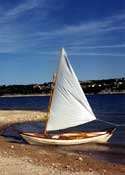
Figure 1a |
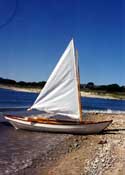
figure 1b |
(click thumbnails to enlarge) |
Many whale boats—a real study in efficiency—used
the Sliding Gunter, particularly in the Azores. The whalers found
a long mast hanging over the end of the boat was not an asset
when attached to several tons of a very angry whale. Also, stepping
and un-stepping a shorter mast was easier and faster for the whalers
and that, of course, applies to the recreational boater, as well.
Yet all this convenience and ease comes in the same size and shape
as the Bermuda sail.
The sail is convenient but is it fast? Yes, according to Jeremy
Howard-Williams in Small Boat Sails. He found that wind tunnel
tests showed the Gunter was as fast on the wind as the Bermuda
and actually faster off the wind. Also, C.A. Marchaj in Sail Power
gives the Gunter very high marks for aerodynamic shape and lower
induced drag. According to Marchaj, the Gunter achieves the same
effect as the Bermuda with a bending mast. But the Gunter does
it without all the high-tech gear that comes with a bending mast
Bermuda. This allows the Gunter sailor to get high-tech results
with low-tech gear.
s.gif) Figure 2
Figure 2 |
Detractors of the Gunter rig are quick to point out that the
yard falls off from the mast on a beat to the wind, creating turbulent
air flow and is therefore slower than the Bermudian sail. The
debate on this can be complicated with both sides quoting data
to make each case. Perhaps the main question the builder must
ask is “Do the advantages outweigh the disadvantages?”
And an understanding that choosing any sailing rig is always giving
up an advantage to gain another.
One of the main advantages of the Gunter rig doesn’t become
obvious until the sail is reefed. Then the spar comes down as
well and brings its weight with it. The photos in figures
1a and 1b illustrates how this
not only maintains a low center of effort for the sail, but also
eliminates the extra weight of the mast aloft. This has a very
positive effect on a boat in strong winds.

figure 3a |
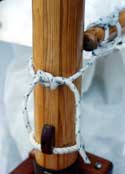
figure 3b |
The Sliding Gunter is a good example of the low-tech versatility
of traditional sails. The number of rigging variations with this
sail is amazing. The builder can rig the boat with a simple combination
of mast, spar, and sail- or a carefully thought out system that
is perfectly suited to his or her sailing needs. Such a system
can be crafted with the builder using nothing more than wood,
rope, needle, thread, and marlinspike skills
A Gunter yard or spar can be as simple as a square piece of light-weight
wood, with or without a taper or as Willits D. Ansel indicates
in The Whaleboat even a piece of bamboo. At the other
end of the spectrum is the graceful, curved bird-wing yard. The
use of the curved yard and full length battens allows this Gunter
sail to come very close to the RAF Spitfire wing. The Spitfire
wing shape provides the most amount of lift with the least amount
of induced drag. Figure 2 shows a comparison
of the Bird-wing Gunter sail and the elliptical, u-shaped RAF
wing. Yet, for all its high-tech appearance, it is nothing more
than wood, cloth, and rope.
 figure 4
figure 4 |
Modification doesn’t stop with the shape. The yard can
use jaws or it can be jawless. The jaws can wood, plywood, or
a simple piece of line. The yards in Figure 3a
and 3b use a simple toggle and a roband. Both
are easy, effective methods of keeping the yard captive at the
mast; yet allow the yard to slide freely. If either of these systems
are used on boats in the 18 to 20 foot range are larger, it will
be better to use parrel beads and service the line. The parrel
beads and the stiffness added by the service will help keep the
yard from jamming. The Drascome Longboat, a British 22 foot fiberglass
production boat, uses parrel beads with the jaws of its Gunter
rig (figure 4) and even though the jaws are made
of metal, the general shape would be easy enough to reproduce.
 figure 5
figure 5 |
All the rigs, simple and complex, start with the sail laced to
the Gunter yard. The luff should be tight but not stretched hard.
A little experimentation will determine the proper tension. The
next step is to lace the sail to the yard. The marlin hitch shown
in figure 5 is probably best if the sail is left
bent to the yard. It’s fast and holds the sail securely.
Actually, there is really no reason to remove the sail each time
the boat is used. Round lacing or back-and-forth lacing is faster
but doesn’t secure the sail as well. Robands can be fast
but allow even more sail movement.
Not only are there several possibilities of attaching the sail
to the yard but there are several ways of attaching it to the
mast as well. It can be loose-luffed, that is attached to the
mast only at the tack, which according to Phil Bolger is more
correctly a Solent Lug Sail rather than a Gunter variation. Or
the luff can be bent on with robands, toggles, or wooden hoops.
The Drascome Longboat uses toggles, which is simple and fast and
the Mirror dinghy, Jack Holt’s famous design, uses lacing.
Over 60,000 Mirror dinghies actively racing means there are a
lot of owners lacing the sails to the mast. Other racing designs
use tracks to eliminate the gap between the luff and mast. The
owner can be as simple or complex as he or she wishes to be.
 figure 6
figure 6 |
This variety carries over to the sheeting of the sail as well.
There are at least three sheeting possibilities with a loose-footed
or boomless sail. A bridle and a single sheet allow the tiller
to operate without fouling the mainsheet. A block, a brass thimble,
or wooden lizard can be used for the sheet to feed through but
a block produces the least drag on the mainsheet. It’s also
possible to use two mainsheets. The leads can be as simple as
wooden pins or thumb cleats on the rail (figure 6)
or brass thimbles seized into line. Using two mainsheets has the
advantage of allowing the sail to be sheeted pass the center line
of the boat—acting like a traveler on a modern rig. While
this will improve the boats pointing ability it adds the complication
of more line to tangle. On some boats it maybe necessary to use
a purchase on the single mainsheet. Most small sails won’t
need this but if the sail area dictates it, this system will do
nicely. The systems main draw back is the block at the clew can
raise a lump on the head of the unwary crew member.
Where the mainsheet lead falls might, in fact, determine which
system is used on the boat. To find the sheeting angle, pick a
point in the middle of the luff and imagine a line from there
down through the clew to the sheer of the boat. That will be the
starting point for the sheeting lead but some fine tuning will
probably be required.
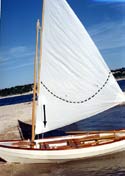
figure 7a |
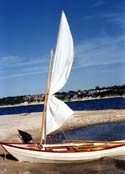
figure 7b |
All the sheeting systems do have one thing in common; the main
sheet is not cleated off. In small boat the sheet should always
be in hand to be quickly eased in puffs. And when the puffs get
too much to handle, a brailing line provides a fast way to douse
the sail without dropping the yard. This useful piece of traditional
rigging can be found on several kinds of loose-footed sails. On
the loose-footed Gunter the brailing line should start at the
luff and loop around the leech to the luff on the other side and
then lead aft (figure 7a). Brass thimbles sewn
to the sail will act as fairleads for the light line. As the brailing
line is hauled in the loop collapses pulling the leech to the
mast (figure 7b). With the sail collapsed against
the mast, dropping the yard can wait until a more convenient time.
Now the boat can be rowed, work can be done or a sandwich eating.
To get under way again, just reverse the process.
 figure 8
figure 8 |
Variations don’t stop with the sheeting, as the halyards
can be rigged in several ways as well. But regardless how the
halyard is rigged, raising and lowering the sail will be much
easier if the halyard is attached at a point that makes the yard
bottom heavy. A bottom heavy spar will be more likely to behave
when it’s quickly run up or lowered. The simplest system
is a single halyard belayed at the mast. The main problem with
this occurs when trying to reef the sail. Unless the boat is beached,
the spar will start to swing wildly as the halyard is eased to
put in the reef. This can be over come somewhat by adding a toggle
below the point the halyard attaches to the spar as shown in figure
8. The toggle holds the yard captive as the reef is put
in or the sail dropped. A similar method in figure 9
is found in John Leather’s Spritsails and Lugsails. If the
parrel line and halyard are led aft and belayed at the center
board trunk, the sail can be raised and lowered from the helm.
While this can be an advantage it does add more line in the boat.
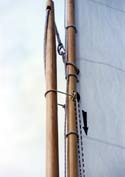 figure 9
figure 9 |
Either method will help control the sail and yard. And control
is very important in small boat. The sailing canoes of the 1890’s
and early 1900’s developed quite a few very clever ways
of controlling sails as well as yards and quickly shortening sail.
Several of these small craft made some impressive and incredible
voyages. S. R. Stoddard made a 2000 mile journey down the Hudson
River, up to the Bay of Fundy, through the St. Lawrence Seaway,
and back to Lake Champlain in Atlantis, a 20 foot sailing
canoe. No less impressive is Frederic Fenger’s 500 mile
voyage through the Caribbean in his 17 foot Yakaboo.
These narrow, unballasted and tender craft demanded almost instant
reefing, particularly in the open waters encountered by Stoddard
and Fenger. Dixon Kemp in his Manual of Yacht and Boat Sailing
details three or four of these types of rigs. A variation of a
rig on Nautilus, another famous sail canoe of the 1890’s,
is shown in figure 10. Control is provided with
two lines, battens and a topping lift. To reef this sail the halyard
is eased as the reefing line is hauled in and made fast, then
a final tug on the halyard tightens the luff.
-.gif) figure 10
figure 10 |
Sailing canoes of the St. Lawrence River and other areas used
another wrinkle called a “Batwing” sail. With the
addition of not more than two battens, the shape takes on the
highly efficient shape of the RAF wing (figure 11).
All of this is done with straight battens, a straight Gunter yard
and components made by the builder. It looks very similar to sailboard
and catamaran sails but pre-dates them by about 100 years.
The “Batwing” and related sails may be too complicated
for the needs of some builders but just adding a sprit boom to
the basic mast, yard, and sail still keeps the system simple.
The biggest advantage of the sprit boom is the “self-vanging”
effect off the wind. As the mainsheet is eased, the angle of the
boom tightens the leech. This helps stop the boat rolling when
sailing off the wind. Also the sprit boom can control the camber
of the sail by adjusting the snotter (the line that attaches the
sprit boom to the mast). As the wind kicks up, the snotter is
hauled in to flatten the sail and the process is reversed to increase
the camber in light winds. The photos in figure 12a
and 12b shows a rig that leads the line aft allowing
adjustments to be made from the helm. On larger boats it will
probably be necessary to have a purchase on the snotter in order
to flatten the sail.
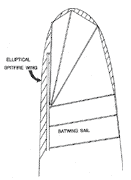 figure 11
figure 11 |
A sprit boom can be added after the fact to a loose-footed sail,
but it’s better to decide the way the sail will be rigged
before it’s ordered or made. A sail for a sprit boom can
have a little more camber because the control the sprit offers
and the foot will need to be cut flat or with very little round.
Obviously, the more complicated the sailing rig, the more information
the sail maker will need. The “Batwing” or the “Birdwing”
Gunter will need much more thought from the builder and the sail
maker than the simple loose-footed sail.
Also, with a little thought from both the builder and sail maker,
a boat that has an existing Bermuda rig can be changed over to
a Sliding Gunter. Because the sails are the same shape, the center
of effort will be the same-or about the same- with both sails.
This means the same mast step can be used without changing the
balance of the boat. In some cases the existing sail might be
re-cut, making the transition even easier. The process is even
simpler if the boat is not completed. However, the builder should
check with the designer before changing the type of sail to avoid
changing the balance and performance of the boat.
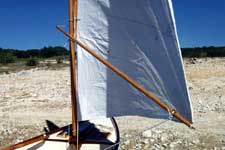
figure 12a |
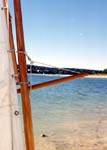
figure 12b |
So, whether you’re retrofitting an existing sail or rigging
a new one, the Sliding Gunter has a great deal to offer. The advantage
gained with the short mast and spars, by itself, make this sail
worth considering. But perhaps its greatest appeal is the ability
to design and construct a sailing rig that is perfectly suited
to the builder’s or your personal needs. Also, another advantage
of the Gunter Rig-and traditional sails in general-is they are
made by the builder and therefore repairable by the builder. This
makes the Sliding Gunter a versatile and effective sailing rig
with a great deal to offer.

Be sure to visit David's website:
arrowheadboats.com

|

